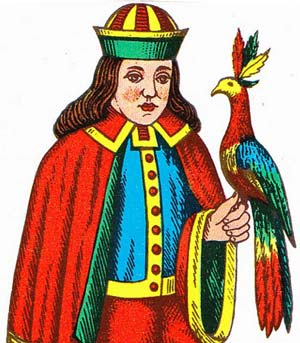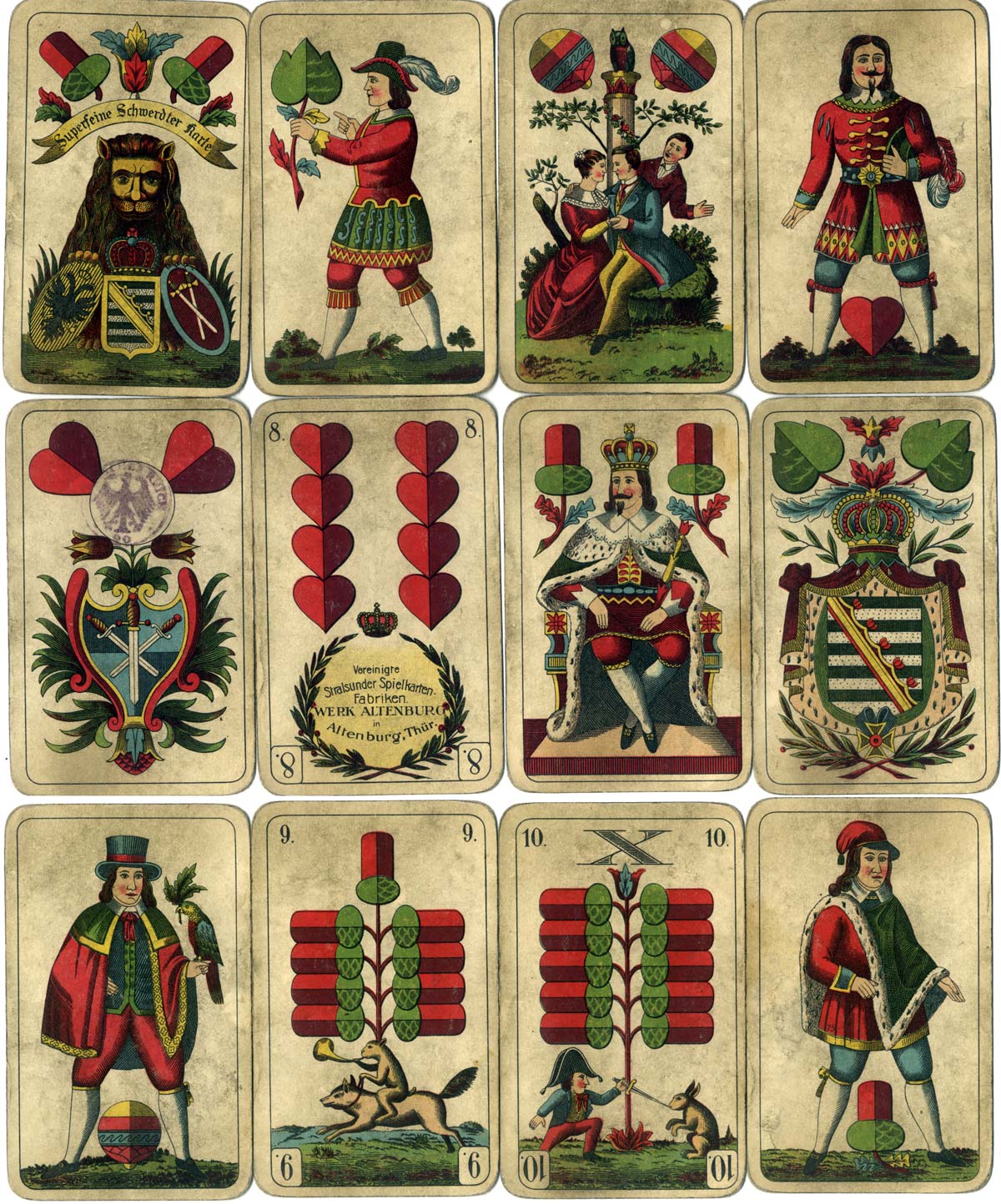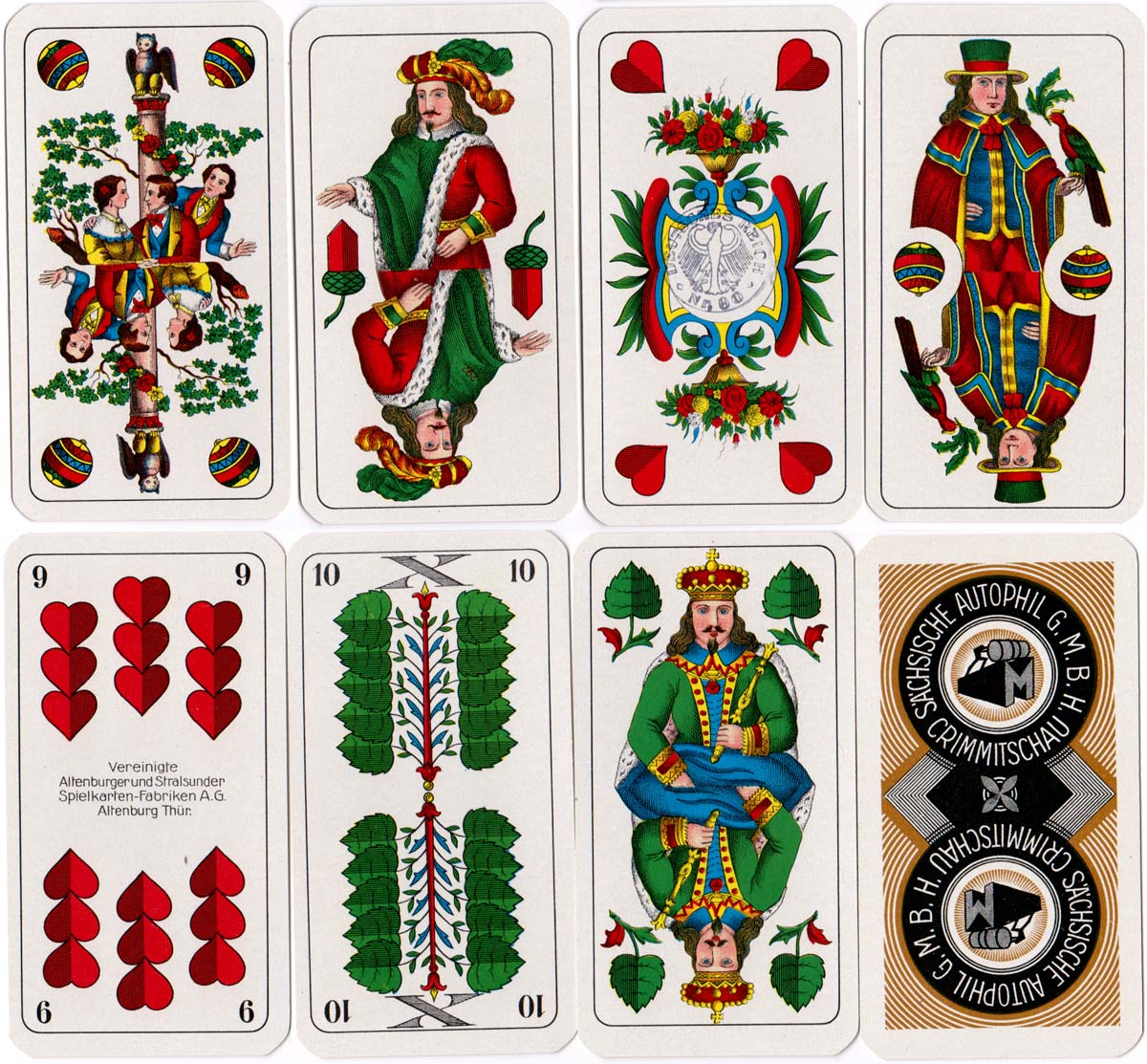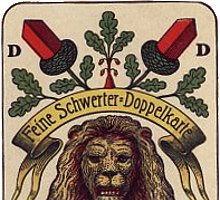German Saxon Pattern
The German Saxon Pattern or “Schwerdter Karte”.

The designs for the Saxon pattern probably originated in the 18th century, making it one of the older German-suited patterns. The Saxony coat-of-arms appears on the daus of acorns (under a lion's head) and on the daus of leaves. The pack is usually described on the daus of acorns as “Schwerdter Karte” or “Schwerter Karte” referring to the crossed swords on the coats-of-arms. The four kings are seated on thrones, each one having two suit symbols. The upper and lower knaves are all civilian figures, and the unter of bells has a bird perched on his wrist. In earlier versions six of the knaves wear hats with upturned brims, but in later versions the costumes have changed style and the unter of bells and the ober of leaves have top hats. The daus of bells shows a loving couple about to be discovered by a third person and the number cards have small decorative vignettes at the bottom.
The pack usually has 32 cards and was used principally for the game of Piquet in the early 19th century. It is known in single-figure and double-ended versions.
Earlier designs
These cards are a reproduction of an original from 1832 and feature the knaves wearing hats with upturned brims rather than top hats. Also the tunics are simpler in style than later versions and there is no ground beneath the courts' feet.

Above: cards from the Saxon pattern by VEB Altenburger Spielkartenfabrik, c.1986, reproducing an original design from 1832.
Later designs

Above: "Superfeine Schwerdter Karte" single-ended Saxon pattern, WW1 tax stamp on 2H, manufactured by Vereinigte Stralsunder Fabriken, c.1920. Some of the vignettes on the numeral cards are variations from the tradition and also the court figures are shown standing on grassy ground. Note the top hats which have replaced the softer headwear.
Double-ended Version
In the double-ended versions, although more convenient, many charming features of the designs are lost.

Above: cards from the double-ended Saxon pattern by Vereinigte Altenburger und Stralsunder Spielkarten-Fabriken A.G., 1932. 32 cards in box with advertising for Săchsische Autophil G.M.B.H. Crimmitschau.


By Simon Wintle
Member since February 01, 1996
I am the founder of The World of Playing Cards (est. 1996), a website dedicated to the history, artistry and cultural significance of playing cards and tarot. Over the years I have researched various areas of the subject, acquired and traded collections and contributed as a committee member of the IPCS and graphics editor of The Playing-Card journal. Having lived in Chile, England, Wales, and now Spain, these experiences have shaped my work and passion for playing cards. Amongst my achievements is producing a limited-edition replica of a 17th-century English pack using woodblocks and stencils—a labour of love. Today, the World of Playing Cards is a global collaborative project, with my son Adam serving as the technical driving force behind its development. His innovative efforts have helped shape the site into the thriving hub it is today. You are warmly invited to become a contributor and share your enthusiasm.
Related Articles

VEB Kombinat Kali
Advertising pack depicting old means of salt production, with designs by Hannelore Heise.

Burghausen
Historical figures and buildings to promote the town of Burghausen, with designs by Jonny Petri.

Wiener Pattern – Nuremberg Version
A classic deck in a new illustrative style, with notable variations in line work, detail, and colour...

CARD-AB Miltenberg
Illustrations by Rita Stern depicting notable landmarks and scenes from the town of Miltenberg in Ge...

New Altenburg Skat cards – German DDR Pattern
Authentic Altenburger Skat cards with German suits (Acorns, Hearts, Leaves, Bells).

German Travel Cards
A travel-themed educational deck helping American tourists visiting Germany.

French Revolutionary cards by Pinaut
Seven cards from a French Revolutionary pack by Pinaut featuring characters from classical antiquity...

Briefmarken-Quartett
Quartet game featuring postage stamps from the Zones of Occupation in post-WWII Germany.

IG Chemie Papier Keramik
Promotional pack designed by Karl-Heinz Schroers for a German trade union with comical bears on the ...

Engel-Tarot
Set of major arcana designed by Alois Hanslian depicting angels throughout.

Virgil Solis
Remarkable pack of 52 animal-suited playing-cards designed and etched by Virgil Solis.

Politiker-Skat by Bubec
Caricatures of world leaders, including many German politicians, by the artist Bubec.

Le Poker Politique
French politicians and various world leaders caricatured by the German artist Bubec.

Modern Jass (Fredy Sigg)
Caricatural updating of traditional Swiss Jass cards by the artist Fredy Sigg.

Rouen Pattern - Portrait Rouennais
An attractive XV century French-suited design from Rouen became the standard English & Anglo-America...

Unimog UX 100
Cartoons promoting the Unimog UX 100, a small truck produced by Mercedes-Benz.
Most Popular
Our top articles from the past 28 days

